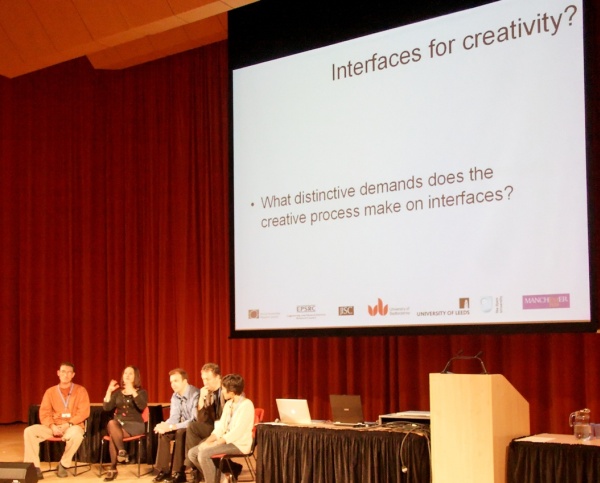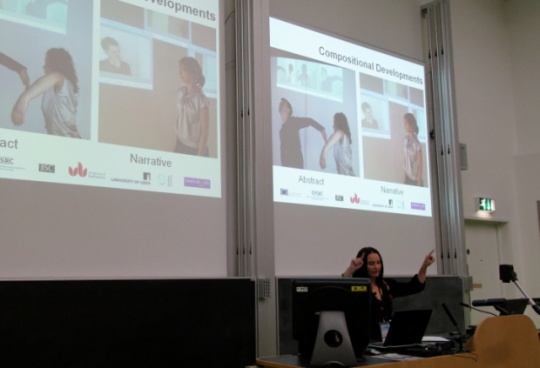23
09
2008
The presentation consisted of a related group of projects under the theme of interfaces; sort of sub title ‘where is the interface’. A sub-context was on tool building and their use. There were a few comments and questions during and after the set of presentations.
- Couple of questions considered the use of ‘visualization’ tools that could be used in the creative process, and creating new processes. This was an area of obvious exploitation.
- An issue was the new choreographic modes developed.
- Also interest was raised in new annotation methods – and what an interface for practical purpose may be needed.
- A comment asked what was new with this mix of telepresence; and an important emphasis needs to be the research benefits that choreography gains from ‘pushing e-science to the limits, as well as importantly the reverse that is the benefits HCI and the e-science communitybenefits from the project. Onecurrent benefit for e-science has been thinking of interface design without being encumbored by the ususl Apple/MS Windows philosophies.
- Tool reuse – how much customisation should there be and if we are suporting the right tool base. There is a continual debate over which tools to use and if it is easier to develop or search for other tools already there with similar features to those required.

Comments : No Comments »
Categories : Uncategorized
18
09
2008
      
We all managed to get together for one day during DRHA 2008, University of Cambridge, UK, 14-17 September http://www.rsd.cam.ac.uk/drha08/ . It was great to have the chance to catch up after a summer of really interesting activity on the project. Sita, Martin, Simon and myself (together with Scott Palmer from University of Leeds) were all participating in a panel that we had proposed for the conference. We presented three projects Stereobodies/Choreographic Morphologies (Martin and I) http://kato.mvc.mcc.ac.uk/rss-wiki/SAGE/StereoBodies , Projecting Performance (Sita and Scott) http://www.leeds.ac.uk/paci/projectingperformance/home.html and e-Dance (Simon and I). The focus of the panel that brought the three projects together, was concerned with the role/function/construction of ‘interfaces’ in dance.  The panel abstract summarised the dicussion as follows;Â
“This panel will discuss visual communication interfaces in dance performance environments through the frames of three current/recent projects. These projects use digital technologies to facilitate non-co-located performances, either between dancers at different sites or between on-stage dancers and off-stage operators. The three projects offer intersecting yet distinct perspectives on this process. The panel will question how such interfaces are experienced by th performers, how they can be approached as choreographic environments, and how they affect the rpocess of viewing. In an art form that prioritises physicality and embodied knowledge, how do dancers negotiate their performances with remote partners via digital interfaces? how might such interfaces redefine choreographic understandings of embodied spatio-temporal relationships? How might spectators engage differently with performances that exist in their entirety only at the boundary of the digital interface?”
This set of presentations, together with All Hands last week served as a really good opportunity for reflection at the half way point in the project. We also had the chance to have some good discussions about where we are heading. The next ‘Project Sandpit’ will take place on 9-10 October in Manchester. So that will give us the space to map out the next few months activity and chart the direction for developments with Compendium/Cohere.
Comments : 1 Comment »
Categories : Dissemination, Event, Team, Theory, Uncategorized
15
09
2008

It’s always a nice feeling when a book you’ve been working on for months finally lands on your doormat, and so what better way to kick off the week than to proudly hold up Knowledge Cartography: Software Tools and Mapping Techniques!
Co-edited with KMi Research Fellow Ale Okada, and NESTA Fellow Tony Sherborne, Creative Director at the Centre for Science Education at Sheffield Hallam U.
We summarise the book’s orientation in the preface:
While “sense†can be expressed in many ways (non-verbally in gesture, facial expression and dance, and in prose, speech, statistics, film…), knowledge cartography as construed here places particular emphasis on digital representations of connected ideas, specifically designed to:
I. Clarify the intellectual moves and commitments at different levels.
(e.g. Which concepts are seen as more abstract? What relationships are legitimate? What are the key issues? What evidence is being appealed to?)
II. Incorporate further contributions from others, whether in agreement or not.
The map is not closed, but rather, has affordances designed to make it easy for others to extend and restructure it.
III. Provoke, mediate, capture and improve constructive discourse.
e-Dance’s mission is to explore how an approach such as this — which emphasises clarity and rigour of thought, making relationships explicit between ideas — meshes with the modes of cognition and creativity that we find in choreography. Tomorrow at DRHA’08 in Cambridge, we’re hosting a panel session reflecting on the changing possibilities of the digital interface that performers, choreographers and audience may now encounter with dance. Thinking specifically about mapping memetic, intellectual worlds, we might muse the following:
- The concept of “memetic media†is quite an interesting one, pointing to the fact that e-Dance media fragments can have ideas behind them that are being crafted by the choreographer within a knowledge mapping tool
- In terms of the knowledge mapping interface, it’s possible that performers might not see this at all, if it is primarily a tool for the choreographer to reflect on discussions in rehearsal, to maintain her multimedia research archive, and to craft performance and/or research narratives (e.g. paths of ideas)
- Another scenario is that the knowledge mapping interface is exposed to performers, as a useful visualization for discussion, eg. of how ideas develop in the unfolding of a piece, or to show spatial configurations
- Yet another scenario is that the tools generate visualizations of memetic media fragments that are good enough to use as part of the performance, eg. dancers trigger, and/or respond to visualizations
- It is possible that visualizations of the connections between ideas, themes, moods and media fragments might literally provide an orienting map for audiences to follow the connections between activity in different locations and times.
Comments : No Comments »
Categories : Publication, Software
11
09
2008

http://www.allhands.org.uk/2008/programme/index.cfm
Just back from the UK e-Science All Hands Conference 2008 held at the University of Edinburgh. Our presentation was part of the Workshop led by Lorna Hughes, CeRCH http://kcl.ac.uk/iss/cerchfocusing on the use of e-Science in the Arts and Humanities – “e-Science in the Arts and Humanities: Early Experiments and Systematic Investigations”. The morning session, of which we were part, concentrated on arts/e-Science projects that, broadly speaking, fell into the ‘beyond text’ category. In other words those projects that were using e-Science tools as a means of both doing and presenting research in forms that were not primarily concerned with linguistic modes of communication. Sally-Jane Norman gave a great presentation in this session on her AMUC project (Associated Motion capture User Categories)  http://culturelab.ncl.ac.uk/amuc/ . I was particularly interested in her thinking about the use of mo-cap for social interaction analysis.  She also clearly articulated the significance of tacit knowledge in embodied practices and the need to recognise and assign value to this methodologically.
Our presentation was based on our paper that has been shortlisted for the peer review process for publication in the Royal Society’s Philosophical Transactions A. Here is a pre-print version of the article:
Bailey, H., Bachler, M., Buckingham Shum, S., Le Blanc, A., Popat, S., Rowley, A. and Turner, M. (2009). Dancing on the Grid: Using e-Science Tools to Extend Choreographic Research. Philosophical Transactions of the Royal Society A, 13 July 2009, Vol. 367, No. 1898, pp. 2793-2806. [PDF]

Comments : 2 Comments »
Categories : Dissemination, Publication








